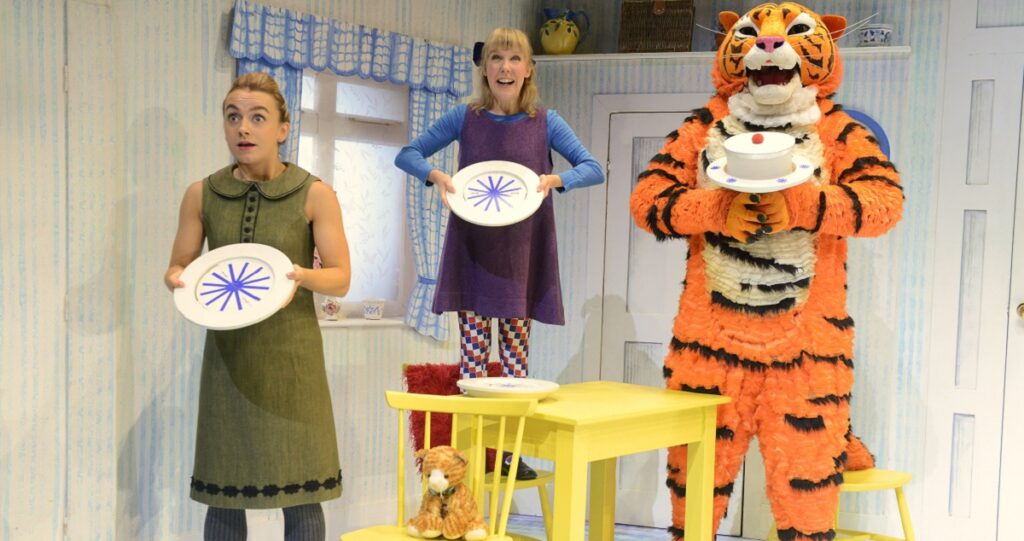Aylesbury Waterside Theatre – until Sunday 31 March 2024
Reviewed by Sue Portman
4****
The doorbell rings just as Sophie and her mummy are sitting down to tea. Who could it possibly be? What they certainly don’t expect to see at the door is a big, stripy tiger!
Direct from the West End, the Olivier Award nominated smash hit show, The Tiger Who Came to Tea returns on tour.
Join the tea-guzzling tiger in this delightful family show; packed with oodles of magic, sing-a-long songs and clumsy chaos. Don’t miss this stunning stage adaptation of the classic tale of teatime mayhem … expect to be surprised!
This was a short show of some 55 minutes, played by three actors. It is only on for two days with several afternoon and evening performances.
The actors were Tia Bunce as Sophie, Ellie Shove as Mummy and Joseph Saunders as daddy/milkman/postman and the tiger.
As an adult – and not taking any children, (unless my husband counts!) I wanted to see this through the eyes of a child so I dug deep into my past life and watched the story unfold with Bunce, Shove and Saunders setting the scene through words and song. All three nurtured the audience into a state of expectation – as the kids wanted to see the tiger! Each time the door knocked and we expected the tiger to appear it was someone else, the father, a milkman or a postman. Would the next knock be the big cat?
The actors whipped the audience up into a state of expectation, using a big clock on the wall. Tick tock, tick tock, tick tock went that clock as they sang and moved in unison quite wonderfully around the stage in a mesmerising choreographed routine to depict the passage of time. There was breakfast and lunch, but we all wanted it to be tea-time as
that’s when the tiger would arrive after all.
When this finally happened – and it was a sort of ‘he’s behind you’ moment, the kids went wild as this huge, beautiful, striped tiger with a massive noble head made an entrance and began his strange engagement with the mother and daughter, promptly eating them out of
house and home, then disappearing never to be seen again.
He ate all their food and even drank their water supply. Greedy tiger! All this and he never spoke a word.
Throughout there was a sense of pantomime meets Playaway (remembering Brian Cant) as Bunce in particular established a warm rapport with the audience, and her colleagues assisted in getting the happy throng singing along at various stages. The kids love to growl – that’s for sure. Adults playing as and for kids is difficult and an art in itself and these three actors were clearly experts in their field, enjoying their work.
There was a sense of loss for kids when the tiger disappeared. I could hear it in their groans and silences in equal measure. They must have been wondering why the tiger arrived at this house and why did he have to leave. Where did he go? Why a tiger at all?
So, what does the tiger represent? Much has been written about this, ranging from loss to representation of unwanted guests not only at our house but in life draining us of all we have then moving on. For sure, the tiger was both cuddly and malevolent depending upon how you wished to interpret it, and the focus was on this fascinating feline throughout as
it drew the kids into his world.
There was a good old singalong about yummy, scrummy sausages and chips before the final curtain and the kids joined in with gusto.
The manner in which these three excellent actors portrayed the story demonstrated some level of love and affection between the tiger and the family but you always felt that he wanted things his way or not at all. A sense of manipulation was clear (for an adult anyway) and this is certainly darker than the nice posters would portray. It was an excellent interpretation of the story, it really was.
In the end, the family had nothing to eat and they had to drive out to a café for their supper. So the tiger was happy, but at the expense of the hosts. Read into it what you will but this was all delivered in an intelligent way, with a simple but effective stage set and some really clever ‘magic effects’ especially when the tiger made plates full of food disappear,
scoffing avidly as the mother and daughter (and audience!) watched on with incredulity.
But this is a show for kids right? Wrong! I mean, if you did not know what year you were born what age would you be? We all have something of the child inside us, which is why we visit the pantomime every Christmas. It is the child-like humour and imagination that can remove the dust of countless years from our souls for a couple of hours at least.
The excited children all came with their tiger tee shirts and tiger toys and left with a sense of bewilderment to some degree. Really they are the ones who should be writing this review, because only in their heads can they reveal what they think the story is all about. Judith Kerr wrote it in 1968 and it is as relevant now as it was then, whether you see it simply as a tiger who came to tea or a metaphor for something else.
I am for the first time going to take some words from Wikipedia about just how this play has in some quarters been interpreted.
Kerr invented the story after visiting a zoo with her three-year-old daughter. She said her husband Nigel Kneale was away making a film and “it felt a bit lonely and we wished somebody would come. We’d been to the zoo so it seemed reasonable for a tiger to come. We both thought they were incredibly beautiful.” She told the story many times before making it into a book which took a year to write and illustrate.
Former Children’s Laureate Michael Rosen has drawn parallels between the book and the author’s life. Kerr spent her early years in Berlin just before the start of the Third Reich and her father was on a death list because of his opposition to the Nazis. Her family fled Germany and most of their property was seized in 1933 when she was nine years old. Rosen claims the tiger could be based on her memory of the past threat: something that could have disrupted her life as a young child and taken everything the family owned.
He said “Judith knows about dangerous people who come to your house and take people away. She was told as a young child that her father could be grabbed at any moment by either the Gestapo or the SS – he was in great danger. So I don’t know whether Judith did it consciously or not – I wouldn’t want to go there – but the point is he’s a jokey tiger, but
he is a tiger.” Kerr, however, stated more than once that the tiger represents nothing more than a tiger, and had no relevance to her upbringing.
This performance is only on for two days bit I am sure it can be seen around the UK. If you get the opportunity go and see it (with or without children) because the actors, crew and the story itself deserve support.
Interpret it as you will, but just enjoy it.

